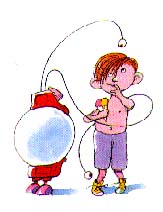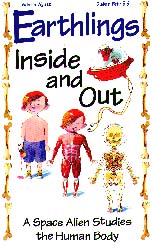|
________________
CM . . . .
Volume VI Number 18 . . . . May 12, 2000
excerpt: Pete had been probed and scanned and X-rayed. He had found out that his hair was dead, his heart was the size of his fist, and he had fewer bones than a dog. He had even offered to share his french fries with an alien. Now he'd had enough Unfortunately, Danoid hadn't.  Earthlings Inside and Out is a quite successful attempt to present a great deal of factual material
in a way that will appeal to a majority of kids. An encounter between the book's protagonist,
Pete, and an alien named Danoid is used as a hook to capture kids' interest. Danoid curiously
questions Pete about the workings of his body and then uses his alien sensors to probe and
discover for himself how the human body works. Various anatomical themes (hair, digestion,
bones, senses) are explored, with each new topic cleverly woven around the various incidents
that happen as Pete chats with Danoid by the beach. Watercolour illustrations, ranging from
entertaining depictions of the encounters between Pete and Danoid to some very detailed
anatomical illustrations, appear throughout the text.
Earthlings Inside and Out is a quite successful attempt to present a great deal of factual material
in a way that will appeal to a majority of kids. An encounter between the book's protagonist,
Pete, and an alien named Danoid is used as a hook to capture kids' interest. Danoid curiously
questions Pete about the workings of his body and then uses his alien sensors to probe and
discover for himself how the human body works. Various anatomical themes (hair, digestion,
bones, senses) are explored, with each new topic cleverly woven around the various incidents
that happen as Pete chats with Danoid by the beach. Watercolour illustrations, ranging from
entertaining depictions of the encounters between Pete and Danoid to some very detailed
anatomical illustrations, appear throughout the text.Interspersed with the dialog between Danoid and Pete are boxes of interesting related trivia (called "earthdatabanks"), reports from Danoid to his Commander explaining human workings from an often humorous alien point of view, and science experiments illustrating the concepts. The ideas for experiments are one of the best features of the book as they are all simple, easy to follow, and clearly illustrative of some anatomical fact. For example, there are experiments designed to measure nerve speed, to measure the amount of air exhaled in one breath, to illustrate the way in which our muscles act upon our joints, and to illustrate how taste and smell work in concert. The book's main drawback is in the flatness of the characters and their conversation. Pete and Danoid are likeable, but one-dimensional individuals. Pete exemplifies the breezy cheeky pre-teen; Danoid the ponderous, literal minded computer based life form. The dialogue between the two is occasionally stilted and insipid. Ironically, although it is the characters of Pete and Danoid that may be intended to draw kids in, the facts, themselves, are so well-presented and explained that they can stand quite well on their own. Recommended. Karen Clay is Head of the William R. Newman Agriculture Library at the University of Manitoba and the mother of two.
To comment on this title or this review, send mail to cm@umanitoba.ca.
Copyright © the Manitoba Library Association.
Reproduction for personal use is permitted only if this copyright notice
is maintained. Any other reproduction is prohibited without
permission.
Published by
TABLE OF CONTENTS FOR THIS ISSUE - May 12, 2000.
AUTHORS |
TITLES |
MEDIA REVIEWS |
PROFILES |
BACK ISSUES |
SEARCH |
CMARCHIVE |
HOME
|
